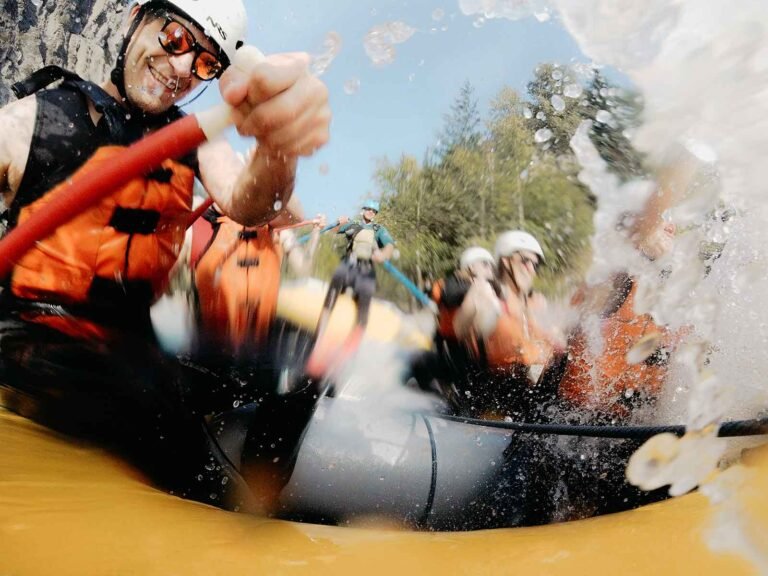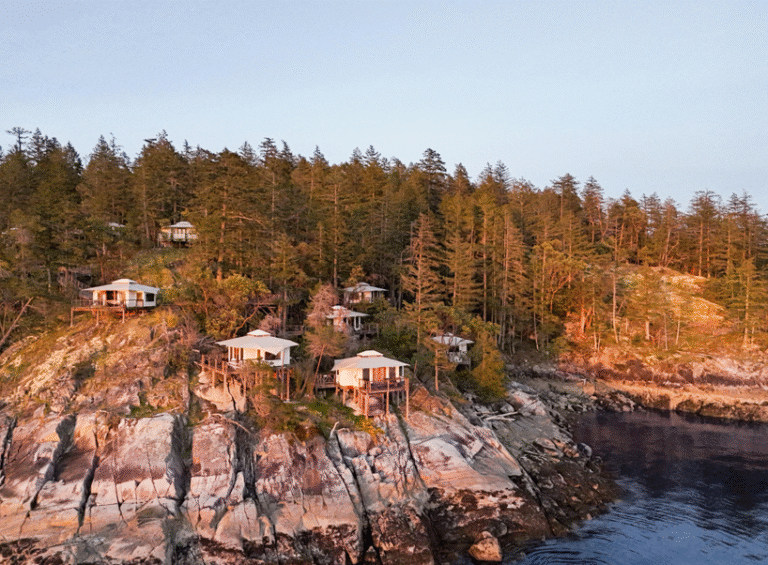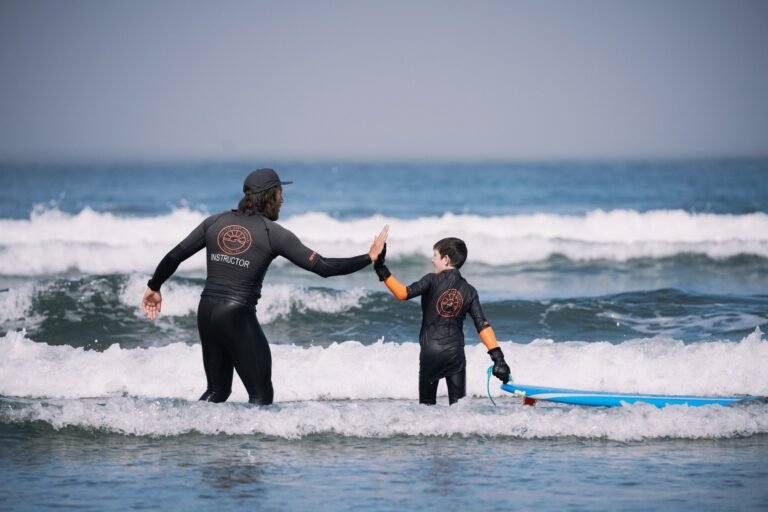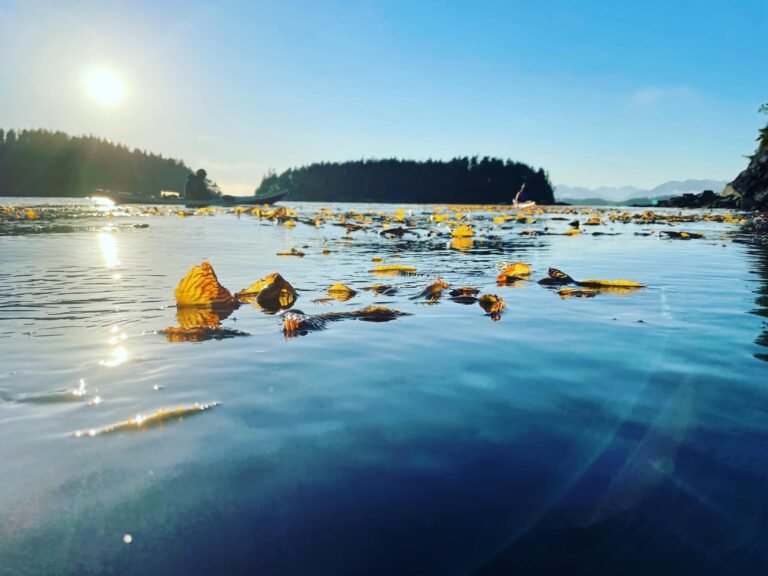Camping space is limited along the shores of Howe Sound. Wherever you decide to overnight, be prepared to share it with sounds from the nearby highway and railway. So close do freight trains come to the sites in Porteau Cove Provincial Park that you might imagine they’re rolling right through your tent. Take heart in the thought that it’s a notch more attractive than having a bear charge through, which is not unheard of elsewhere in the woods of BC.
Porteau Cove is located near the midpoint of Howe Sound, 15 miles (24 km) north of Horseshoe Bay on Hwy 99. As you approach it, the beach and jetty are what first catch the eye. Only in winter, once the leaves are down, is it possible to see through the surrounding forest into the little cove itself, where campsites are located. As this is the only provincial campground on the Sound, campsites are in constant demand from late May to early October. If you’re intent on staying here, arrive early in the afternoon or phone ahead for reservations. A sign posted on Hwy 99 informs travellers when the park is full. Although the vehicle/tent sites go quickly throughout the summer and on Friday and Saturday nights at other times of the year, there is usually a good chance of getting one of the walk-in sites even if you arrive late, except in the months from June to August. A user fee is cikkected for drive-in sites and walk-ins.
As soon as you enter the campground, bear right to see if any of the oceanfront sites are vacant. In the middle of the campground is a washroom facility complete with showers. The walk-in sites are located at the far end of the campground road. An amphitheatre is located between the drive-in and walk-in campsites. Interpretive displays are presented here on summer evenings, one of the most scenic locations in the park. Because there is so little level land, most sites are relatively closely spaced compared to other provincial parks. Tucked in behind the walk-in sites is the cove itself. A stone wall on the west side is one of the few remaining signs of a small settlement that once stood here. There’s a charming sense of formality where an open lawn is laid out beside the cove and a small bridge spans the narrow backwater.
For climbers (and those who cheer them on) there’s a provincial campground at the base of Stawamus Chief Mountain in Squamish. You’ll find spiffy drive-in and walk-in sites in Stawamus Chief Provincial Park. Watch for the turnoff from Hwy 99 at the large roadside interpretive area at the south end of town. The forested campground is located at the south end of a rough road that hugs the base of the mountain. A fee per site per night is charged, and the vehicle campsites are open, usually from late May to mid-September. A gate restricts vehicle access at other times of year, and only the walk-in sites are accessible.
Alice Lake Provincial Park, 8 miles (13 km) north of Squamish, is tucked away east of Hwy 99, just far enough to be buffered from traffic sounds. A short approach road leads to the park gates where signs direct visitors to vehicle/tent campsites. A hush prevails over this lushly forested campground. In part this is due to the thick canopy of western hemlock that shelters much of the park. If you’re lucky, one of the sites near both the lake and the hot showers will be vacant. Bear right at the entrance to reach them. Successive rows of pleasantly spaced campsites spiral up the hillside from the lake. At night, stars are reflected in Alice Lake’s still surface. Best viewing of the open sky and cosmic wonders (such as a moonrise over the peaks in nearby Garibaldi Provincial Park) is done from the beach. Alice Lake Park is predictably busy in summer. You won’t have nearly as much difficulty from September through May – yes, there is winter camping here.
There are three Forest Service recreation campsites in the Squamish region, at Cat Lake and Brohm Lake located just north of Alice Lake, and Ashlu Creek in the Squamish Valley. These are no-frills locations, with few amenities. If you get one with a picnic table, count your blessings. (To its credit, the Forest Service builds the sturdiest log-and-plank tables found anywhere in the province.) Although Cat and Brohm Lakes are easily reached from Hwy 99, Ashlu Creek is farther afield in the Squamish Valley. Follow signs to the Squamish Valley Road west of Hwy 99 opposite the entrance to Alice Lake Provincial Park. Ashlu Creek flows into the Squamish River about 14 miles (22 km) north of the road’s origins in Cheekye. The last 3 miles (5 km) to the campsites are gravel. Cross the Ashlu Creek Bridge and drive down to the river, where there are a number of natural campsites. A short distance farther along is another bridge, beside which are several more open sites. Presently, there is no fee charged for camping at these sites.
One outdoor essential that’s in short supply around Whistler is campsites. This is surprising, given the number of visitors that floods through the Whistler Valley each summer. In its defence, the valley floor is little more than 0.5 mile (less than 1 km) across at its widest point; that doesn’t leave much level space on which to build campsites. You’ll notice this deficiency if you overnight at Brandywine Falls Provincial Park, which is girdled by Hwy 99 on the west and the BC Rail line on the east. Still, the vehicle/tent sites here are in constant use in warm weather. Once snow falls, the campground closes for the winter. Brandywine Falls is located about 6 miles (10 km) south of Whistler on Hwy 99.
A modest brown sign marks the entrance to the campground at Cal-Cheak Forest Service Recreation Site, 2.7 miles (4.3 km) north of Brandywine Falls Provincial Park. Visitors must cross the railway tracks, then journey a short distance beyond to reach the first of three small locales around which rustic campsites are grouped in a pleasant, heavily forested location. The sound of the Cheakamus River and Callaghan Creek, which merge beside the sites (hence the site’s hokey, hyphenated name), helps drown out traffic noise from Hwy 99 and the BC Rail line. Just north of Cal-Cheak, on the west side of Hwy 99, is the beginning of the Callaghan Forest Road. Although the road is rough in places, particularly in spring when frost heaves the ground, if you take it easy it leads to two Forest Service recreation sites. One small campsite is at Alexander Falls, located 4.3 miles (7 km) along the road; a nest of similar sites have been fashioned by years of campers on the shore of Callaghan Lake 9.3 miles (15 km) west of Hwy 99. Of all the campsites in the Whistler region, the view from Callaghan Lake is the best. Too bad there’s no one to monitor activity at the site; partying can carry on well into the night here.
Garibaldi Provincial Park: There’s a roadside viewpoint in Squamish at the town’s lower limits, about 1 mile (1.6 km) south of Shannon Falls on Hwy 99. A plaque here honours the memory of the great 19th-century Italian leader Giuseppe Garibaldi, for whom distant Mount Garibaldi (8,918 feet/2678 m) is named. Fittingly, it is mounted on a large piece of granite quarried from nearby Stawamus Chief Mountain. On a clear day, pause here to admire the remarkable series of geographical formations laid before you: Shannon Falls, BC’s third-highest waterfall, the smooth granite features of the Chief, with Mount Garibaldi and craggy friends on high in the distance. The scene will put you in the same frame of mind as the anonymous crew member on the English Navy survey ship Plumper who christened it in honour of the headline-making freedom fighter in 1860. (Members of the Squamish First Nation call it Chuckigh. The settlement of Cheekye near Brackendale is a variation on this spelling.) In 1927, after vigorous lobbying by the BC Mountaineering Club, the Vancouver Natural History Society, and others who had explored and named many of the most prominent geological features in the alpine region around Mount Garibaldi, a 480,000-acre (195,000-hectare) park was created by an act of the provincial legislature.
There are five main entry points to the park: Diamond Head, Garibaldi Lake, Cheakamus Lake, Singing Pass, and Wedgemount Lake. More trails, such as Black Tusk, Musical Bumps, and Helm Creek, lead hikers back into the park. All approaches are from the west side of the park, and the trailheads are all well marked along Hwy 99 between Squamish and Whistler. The turnoff to Diamond Head is just north of the Mamquam River Bridge, and a 10-mile (16-km) drive is required to reach the trailhead. Hikers benefit from this approach as the road climbs for much of the way to an elevation of just over 3,000 feet (914 m). The turnoff to Black Tusk and Garibaldi Lake is just south of Daisy Lake, 12 miles (19 km) from Whistler. A paved road runs 1.6 miles (2.5 km) east to a large parking lot beside Rubble Creek. A 5.6-mile (9-km) trail to Garibaldi Lake begins here.
Cheakamus Lake is reached by following the 5.3-mile (8.5-km) Cheakamus Lake Rd (also known as Eastside Main). The turnoff is located across from Whistler’s Function Junction neighbourhood. The road that leads to the Singing Pass trailhead begins next to Whistler Village. Follow the signs from Hwy 99 that direct you along Village Gate Boulevard to Blackcomb Way. The access road begins next to the BC Transit interchange and runs uphill for 3 miles (5 km), across the north base of Whistler Mountain. Finally, the Wedgemount Lake trailhead is located 2.5 miles (4 km) north of Whistler’s northernmost neighbourhood, Emerald Estates, just beyond the Whistler town sign. Turn east off Hwy 99 and cross the Green River Bridge, then turn left and head uphill about 2 miles (3 km) on a dirt road. There are signs at each divide pointing the way to the lake’s trailhead.
Although much of the park’s terrain is rock and ice, there are lush stands of mature hemlock, fir, and cedar in places such as Cheakamus Lake. Southwestern slopes around Diamond Head are thickly carpeted with heather, which bears pink and white blossoms in summer, and blueberry bushes which turn every shade of yellow and red imaginable in fall.
There is backcountry camping along the Diamond Head Trail near Squamish in Garibaldi Provincial Park, at Red Heather Campground (3 miles/5 km from the trailhead; moderate; 1 hour), at Elfin Lakes Campground (7 miles/11 km; moderate; 3 hours), and at remote Mamquam Lake (13.6 miles/22 km; strenuous; full day). In addition, there’s a heated overnight shelter with 34 bunks and cooking facilities at Elfin Lakes. To reach the Diamond Head trailhead, turn east off Hwy 99 in Squamish where a BC Parks’ sign indicates ‘Diamond Head (Garibaldi Park).’ This access road runs 10 miles (16 km) to the parking lot at the trailhead. The first 2.5 miles (4 km) is paved, passing through the southern outskirts of Garibaldi Estates. The remainder is along gravel-surfaced Mamquam Road, which climbs gradually above the Mamquam River Valley. The final 2.5 miles (4 km) of road covers a series of switchbacks. Only at the last one does the view of the Squamish Valley open up. This is a good place to stop and look south to Howe Sound, the Stawamus Chief, and Sky Pilot Mountain on Goat Ridge. Across the valley to the west is Cloudburst Mountain, and south of that is the broad body of glaciers around Mount Tantalus.
Camping at Garibaldi Lake in Garibaldi Provincial Park is restricted to two designated areas – Taylor Meadows and the west end of Garibaldi Lake. The hiking distance to both locations is the same, about 5.6 miles (9 km) from the Garibaldi Lake/Black Tusk trailhead, located 2.5 miles (4 km) east of Hwy 99, 12 miles (19 km) south of Whistler. A common trail leads to within 0.6 mile (1 km) of each, then divides. Tent pads and a covered cooking shelter are located at each. Campers must bring their own stoves and be prepared to pack out all refuse. During summer months, there is a camping fee per night per site. When water levels in Garibaldi Lake are high, be prepared to wade a short distance along the shoreline to reach the campsites on its west side.
There are also wilderness campsites at three locations on Cheakamus Lake in Garibaldi Provincial Park. The easiest one to reach is at the west end of the lake, while those at Singing Creek and Castle Towers Creek are more remote. You’ll need a boat (and a couple of hours’ paddling) to reach the primitive site at Castle Towers from the launch at the lake’s west end, which almost guarantees that you’ll usually have the site to yourself. From the trailhead, located about 4 miles (7 km) south from Hwy 99 on Cheakamus Lake Road, it’s an easy 2-mile (3.5-km) hike to reach the first sites at Cheakamus Lake, situated beneath a sheltering old-growth forest. The sites at Singing Creek are a further 2 miles (3.5 km) of moderate hiking along the north side of the lake. Castle Towers Creek enters Cheakamus Lake directly across from Singing Creek.
Elsewhere in Garibaldi Provincial Park, there are wilderness campsites at Russet Lake, 1.2 miles (2 km) east of Singing Pass, and at the northwest end of Wedgemount Lake.
Pemberton / Lilloet
There are two provincial parks in the Pemberton region with well-organized campgrounds. Nairn Falls Provincial Park is located just south of Pemberton beside Hwy 99, and features captivating views and day-use areas. As it flows through the park, the Green River carves its way through a mass of granite at the foot of Mount Currie. Having picked up volume from the Soo River and Rutherford Creek on its way from Green Lake in the Whistler area, it swirls and crashes its way along until it reaches a fracture in the granite. Suddenly, its broad shape is transformed into a thundering column of whitewater as it drops 197 feet (60 m) at Nairn Falls.
As abruptly as the theatrics begin, the river reverts to its former character and hurries on towards Lillooet Lake. Unlike Shannon Falls or Brandywine Falls, Nairn Falls does not drop down a sheer pathway but instead boils through several frothy cauldrons. Over the centuries, silt carried in the water has scoured out bowls in which the whitewater churns momentarily before surging to the rocks below. Clouds of spray are jettisoned above the maelstrom in random patterns that are pleasant and hypnotic to watch. This is one of the most (hydro) dynamic sites in the Whistler region.
If you’re just visiting for the day, park at the picnic area just inside the park gates beside Hwy 99. The 1.1-mile (1.8-km) trail to the falls is smooth and only moderately difficult to walk. Fine views of Mount Currie present themselves along the way. Once at the falls, a wire-mesh fence keeps visitors back from the edge while still permitting a good view of the river’s violent action.
Birkenhead Lake Provincial Park is somewhat more remote, an hour’s drive north of Mount Currie near D’Arcy. It also has mountain-biking trails and paddling and fishing options on the lake. The gravelled Blackwater Forest Service Road leads 10.5 miles (17 km) west from the D’Arcy-Anderson Lake Road to Birkenhead Lake. The park has a wilderness camping area situated 1.2 miles (2 km) from the vehicle/tent sites at the northwest corner of the lake. You can either walk to it along a pleasant trail, or paddle in from the boat launch. (Watch for a large red marker affixed to one of the sturdy trees that surround the wilderness site, indicating where to land.) This is a delightful, arm’s-length approach to camping at Birkenhead. Both Birkenhead Lake and Nairn Falls Provincial Parks fill up quickly on summer weekends. Signs on the D’Arcy-Anderson Lake Road inform visitors when the Birkenhead campsite is full so that travellers don’t make the 21-mile (34-km) round trip in vain.
There’s camping at a variety of Forest Service recreation sites sprinkled throughout the valley and along Lillooet Lake. The Owl Creek sites are located 4 miles (7 km) north of Mount Currie on the D’Arcy-Anderson Lake Road. There are two separate sites on opposite sides of Owl Creek, where it meets the Birkenhead River. Farther north towards D’Arcy you’ll find four campsites beside noisy Spetch Creek in a pleasantly forested location off the D’Arcy-Anderson Lake Road.
Recreation sites on Lillooet Lake are located along gravel-surfaced Lillooet Lake Road at Strawberry Point (road marker 6 Km), Twin Creeks (marker 10 Km), Lizzie Bay (marker 15 Km), Driftwood Bay (marker 16 Km), and at Lizzie Lake on a logging road 7.5 miles (12 km) east of Lizzie Bay. Lillooet Lake Road begins 9 miles (15 km) east of Mount Currie and runs south off Hwy 99.
Residents of the Pemberton Valley have been camping at Tenquille Lake since the 1920s. An old cabin that was constructed there in 1940 is now best left to the pack rats, but it still provides shelter if needed. Access to the lake, the starting point for exploring the surrounding peaks, is from either a trailhead beside the Lillooet River Bridge at the north end of Pemberton Valley, or from a trailhead that begins about 10.5 miles (17 km) north on the Hurley River Road, followed by another 1.2 miles (2 km) on the Tenquille Lake Logging Road. Either way, count on a demanding 7.5-mile (12-km) hike to reach the lake.
Due to the extremely rocky terrain, wilderness campsites at Joffre Lakes Provincial Park are difficult to find. For those who plan to overnight in this park, follow the hiking trail on the southwest side of Upper Joffre Lake to where the alpine forest provides some slight shelter. There are no facilities here other than an outhouse and a few rough camping spots that have been cleared over the years. Campers are expected to remove all traces of their visit. Joffre Lakes Provincial Recreation Area is located on the Duffey Lake Road section of Hwy 99, about 14 miles (22 km) northeast of Mount Currie.
There is less likelihood of being rained out when camping in the Lillooet region than there is farther west in the Coast Mountains. As Hwy 99 leads from Duffey Lake to Lillooet, a provincial park campground and several small Forest Service recreation sites suitable for camping appear beside the lake and along Cayoosh Creek. At the forested east end of Duffey Lake, a provincial campground with rough vehicle/tent sites is the best-organized site and also one of the most scenic, with views across the dark lake to Mount Chief Pascall and the Joffre Glacier Group. The biting insects here are bothersome during much of the summer and are so aggressive that even a steady breeze doesn’t deter them. Several smaller sites are located along Hwy 99 at Roger Creek, Cottonwood Creek, and Cinnamon Creek beside Cayoosh Creek as it flows towards Lillooet.
One of the most extensive campsites in the region is BC Hydro’s Seton Lake Reservoir recreation area, 3 miles (5 km) west of Lillooet on Hwy 99. Located on the south side of the road, vehicle/tent sites are spread out in a forested location beside Cayoosh Creek and are open between May and September. One of the campsite’s more unusual features is an old Chinese stone oven, a remnant of the gold-rush days in the 1800s. A marker points to its location near the east end of the campsite.
Attractively situated Marble Canyon Provincial Park lies 22 miles (35 km) northeast of Lillooet on Hwy 99. Limestone cliffs tower above the campground’s vehicle/tent sites, while the placid waters of Turquoise Lake reflect the sky. A waterfall on the opposite side of the lake pours forth a steady stream; the sound helps mute all else.
As you travel west to east through the Sea to Sky corridor between Pemberton and Lillooet, you enter a transition zone. Coastal terrain gives way to that of the interior, and in the process the alpine tundra biogeoclimatic zone becomes more accessible. Around Pemberton, you may have to hike to an elevation as much as 2,000 feet (630 m) higher to reach the alpine than you would an hour’s drive farther east. A good example of this is at Blowdown Lake, where you’ll find wilderness camping on the alpine perimeter at the 6,700-foot (2044-m) elevation, well below the benchmark of 7,382 feet (2250 m) in Pemberton and Whistler. Gott Peak rises above the lake to the north, while several equally rugged companions flank the lake to the south. Although much of the perimeter of the lake is marshy or touched by snow even in July, there are campsites on higher ground at the south end of the lake. One of the advantages of camping here is that the nearby alpine zone is easily reached for exploring with a lightweight pack.
The approach to Blowdown Lake begins from Hwy 99, 2.2 miles (3.5 km) east of the Duffey Lake Provincial Campground (see above). A logging and mining road climbs more than 10 miles (16 km) from Hwy 99 to Blowdown Pass. Most vehicles can make it as far as 6 miles (10 km) up the road before parking at a level area next to an abandoned metal-and-wood structure. If you have a four-wheel-drive vehicle, it’s possible to go farther, but deep ditches and washouts will eventually halt all but the most hard-core drivers. On foot, it’s a 3.5-mile (6-km) hike to the lake from the metal-and-wood structure, and another 1.2 miles (2 km) to the pass. The lake and camping area lie a short distance from the road.
Campgrounds & RV Parks
Information on Provincial Park Campgrounds and Reservations, National Park Campgrounds and Reservations, Camping on Crown Land in BC Recreation Sites, Frequently Asked Questions on Parks and Campgrounds, and Provincial Park User Fees. Go to Campgrounds & RV Parks.






